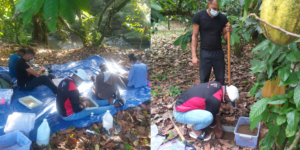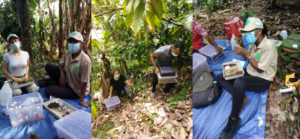The Cacao Forest team have begun a study of the change in the composition of the macrofauna in the cacao plantations in San Cristobal and Duarte provinces.
As opposed to microfauna, the term macrofauna applies to all animals visible to the naked eye, ranging in size from 4 to 80 mm. The soil macrofauna is regarded as an indicator of the functioning and health of ecosystems and sustainable agricultural production.
This study involves comprehensive sampling, focusing particularly on the earthworm, a group of invertebrates essential to measuring soil quality and health.
The main job that earthworms do is creating tunnels up to three metres long. In this way they improve soil aeration, but they do a lot more besides! Earthworms also encourage root growth and improve soil water management. This is because soil ventilated by tiny tunnels can absorb 100 ml of water per hour – a hundred times more than non-living soil. The action of earthworms also reduces erosion and maintains the soil’s pH. Soil populated by earthworms is thus living soil in good health, and this is one of the key conditions for sustainable and profitable agriculture.
This experiment was carried out on 24 plantations in each of the two project provinces. For the study, the plantations were divided into three age categories: 0 to 3 years, 4 to 10 years and 11 to 25 years. Similarly, the invertebrates found were sorted into three main size categories: 0-10 cm, 10-20 cm and 20-30 cm.

Soil samples were taken from different parcels. The results of the different analyses will tell us more about the impact of the biodiversity of the plants cultivated in different soils over time. They will also enable us to make recommendations.
The field samples were taken by small groups of students and technicians working for the Cacao Forest project. Each student was trained to work in a particular study zone. The producers who hosted the students on their parcels will also benefit from the results of the study.












